M4- How to create content clusters
What you will learn: The optimal internal linking structure for websites, the importance of cornerstone content and content clusters, and how to create a content cluster.
Tasks (2): Optimize your site’s internal linking structure, determine the topics for your cornerstone articles and article topics for at last one content cluster
Time: 19 minutes to read the module and xx hours to complete your tasks.

Why internal links are important
- Links help Google crawl your site to learn what it is about and the quality of its content.
- Google uses the number of links to a web page to determine if it is authoritative.
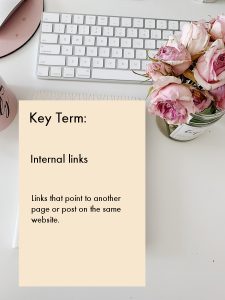
Internal links help Google crawl your website
As we covered in the Basic SEO Course, Google learns about your website by crawling its internal links. It invented two bots to do this: Googlebot Desktop and Googlebot Smartphone, which crawl your desktop site and mobile site, respectively.
The bots begin by crawling your desktop and mobile home pages. It looks for links on your home page and follows these to other pages and posts on your site. By following these links, Google figures out the relationship between the various pages, posts and other content on your site (like category pages and products). It uses this process to determine the main content of your site and and the quality of this content.
Links increase your site’s authority
Your blogging goal is to get Google to see your website as an authority on your targeted subjects. Or to put it another way, your goal is to maximize your site’s domain authority.
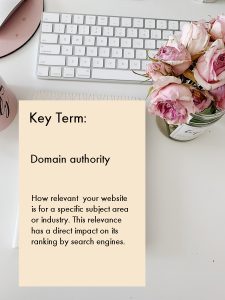
Your targeted subjects are the categories you created in M3. For example, I target the following subjects on my website Bespoke Digital Solutions:
‣ Website design
‣ SEO
‣ Social Media (SEM)
‣ Website hosting
To get Google to see your site as an authority on your targeted subjects, you need to do two things:
- Create content that serves as a reference on a particular topic. It should be well researched and written. Ideally, it should contain unique thoughts, techniques, research and/or conclusions.
- Build links that point to your most important content- the content you want Google to consider you an expert on. This is because Google’s crawlers think a page is important if it has a lot of links to it. The more links, the better. This is true even of internal links. When you link from content in your site to other content in your site, you are sending a message to Google’s crawlers that your content is relevant.
This is how we create your site’s internal linking structure.
Note: As discussed in our Basic SEO Course, there are two kinds of links: internal and external (backlinks). This module discusses internal links. The next course: Take your SEO to a higher level, discusses how to do this with backlinks, which are much more powerful than internal links.
How to optimize your site’s internal linking structure
Think of your website as a pyramid- a step pyramid, not a smooth one. You want your home page on the top. Below that, put your most important content. This is the content that is most relevant and informative to the products/services you are selling. It can include category pages and portfolio pages. Here is an example of the site structure of my agency website:
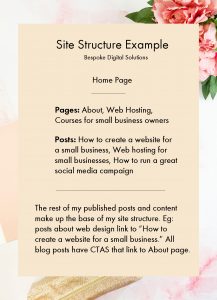
My home page sits at the top of the pyramid, and yours should as well. Why? Because eventually, your home page will have the most links to it as you start building backlinks. Even if your website is new, your home page likely has the most links to it if you have connected your social media accounts to your site. If you haven’t done this already, you should. It’s an easy way to get backlinks to your site.
Let me walk you through why I chose the pages and posts I did for the second step of my pyramid- the content I wish to rank for. As mentioned above, my main services are website design, SEO and social media marketing. Before I created these courses for small business owners, I included an article about SEO in the second step of my pyramid. However, when I created these courses, I decided to funnel my SEO traffic to this subdomain on my website (levelup.bespoke-digital-soliutions.com) so I removed that article from my pyramid. Now, the second step of my pyramid contains the following pages and posts:
Pages
About- I focus on content marketing, which means I create content and optimize it for search to get people on my website. The ultimate goal is to get them to arrange a free consultation. My About page has a link to arrange a free consultation with me, so I put it on the second step of my pyramid. Moreover, all my articles link to the About page.
Web Hosting- This page functions as a landing page for my boutique web hosting company. Since it is difficult to write articles about website hosting that are non-technical, and most of my clients’ eye glaze over when they read technical material, I decided to put the landing page in the second step of my pyramid to make sure it gets the priority it needs.
Courses for small business owners – This is a link to this subdomain (levelup.bespoke-digital-solutions.com). Since I want to funnel all SEO related traffic to this subdomain, I put the link in the second step of my pyramid.
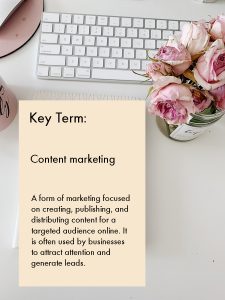
Posts
How to create a website for a small business. This article focuses on the website design portion of my business. I initially created it because I found myself repeatedly explaining the same things to clients- how to get a domain, why they needed web hosting, etc. I tried to find an article on the web that I could send them, but couldn’t find anything comprehensive that was written for clients. So I wrote one and made it cornerstone content by linking all articles on my site about website design to it. All future articles I write about web design will link to this article. This article serves another function: it sends traffic to this subdomain for people that can’t afford to make their own website or do their own SEO and have the bandwith to do it themselves. This article has 1,767 words.
How to run a great social media campaign. This article focuses on social media campaign design and management. It also covers broader marketing topics like branding and sales funnels. All articles I write about social media management and advertising, and broader marketing topics, link to it. The article has 1,208 words.
Website hosting for small businesses: What you need to know. This article is about web hosting. It is cross linked with my web hosting landing page. Any future articles I write about web hosting will link to it. It serves as a reference to new website design clients-I send it to them when they ask questions about web hosting. It answers their questions and is a soft sell for my hosting business. The article has 1,598 words.
Now let us look at the second step of your pyramid. Right now, that step is likely not complete. You are going to write blog articles to make it broader by creating cornerstone content.
Cornerstone content
Writing cornerstone content articles, and using them to anchor content clusters, not only helps you optimize your site’s internal structure. It is also a technique you can use to rank for very competitive key phrases.
You start by finding a head term key phrase for which you wish to rank. It should be about one of your blog’s categories. Then, you write an article that serves as a resource on the given topic. It should be evergreen- meaning the article is not dependent on the news cycle. How to articles, tips and lists are good choices.
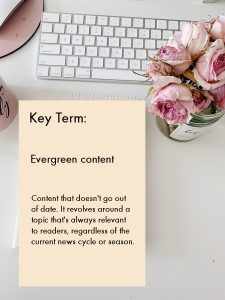
Sneak preview: Once you have the cornerstone article written, you will consistently create articles related to its topic and link them to your cornerstone content. Google will see all these links and know that these are the most important articles on your site. Your end goal is to establish high domain authority for these articles.
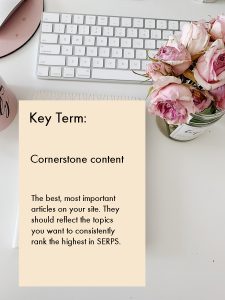
Example: As discussed above, these blog articles are my cornerstone content:
How to create a website for a small business. Key phrase: website for a small business. Word count: 1,767.
How to run a great social media campaign. Key phrase: great social media campaign. Word count: 1,208.
Web hosting for small businesses: What you need to know. Key phrase: web hosting for small businesses. Word count: 1,598.
Notice that they all are about very broad topics and all act as references. In fact, all three were written specifically for clients. Later, I decided they were excellent cornerstone content articles and started linking other content to them. They are all updated regularly.
All of three of these articles are optimized around very competitive key phrases. Because digital marketing key phrases are the most competitive in the world, in terms of organic search, I had to make them longer than the head term key phrases that I recommend for your cornerstone content articles. If you are in a very competitive space, you may need to do this too. As I update them I make them longer so they will eventually be more than 2,000 words.

Task: Using your key phrase research from the Basic SEO Course and your categories from M2, determine the titles, and their associated key phrases, for your website’s cornerstone articles. I recommend one cornerstone article for each of your blog’s categories. When you finish with this, design the second step of your site’s pyramid. Submit these two tasks to Mary Clare for review.
Content Clusters
Unless you have the luxury of trying to rank in a niche business that has very little competition for key phrases, you will need to create a lot of content to rank in the first page of search results, let alone the top 3.
This can lead to a potential problem: for your website to be considered an authority on a subject, you need to publish a lot of content about that subject. However, as we learned in M3, the content can’t be too similar or Google will penalize you. Content clusters can help you rank for highly competitive key phrases and help you avoid being penalized for duplicate content.
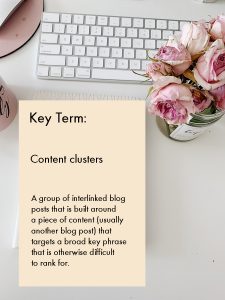
We are going to use content clusters to leverage the following two facts to get your cornerstone content articles ranking highly in SERPS:
Fact 1: Google thinks articles with a lot of links to them have high content authority. The more links, the more authority.
Fact 2: Niche, long tail key phrases are easier to rank for than short key phrases.
How to create a content cluster
- Write articles optimized around niche key phrases that are easier to rank for than your broader, more competitive key phrases.
- Link these articles to your cornerstone content. The more links you have to the article, the more Google authoritative Google will view it to be. This will push it higher in search rankings.
For example, let’s take my cornerstone article: How to create a website for a small business. I created the following articles about website development and design:
How to create and curate the best images for an online store
What are the best colors for websites?
Writing in WordPress Gutenberg Editor
Why you need an SSL and how to install one
Then, I linked them all to the article: How to create a website for a small business.
Video: How to create internal links
Where to put your cornerstone content
As discussed above, typically a website’s home page has the greatest link value. This link value is shared between all the links found on it. This is why you want to feature your cornerstone posts on your home page: Google will see the links directed at your home page and direct them to your cornerstone content. This gives those articles even more link juice.
Tasks: Write a cornerstone article. Then, put it on your home page. Make sure to watch the following video before you begin. If you need help putting the cornerstone content on your home page, you can ask your web developer or use a voucher to contact Mary Clare.
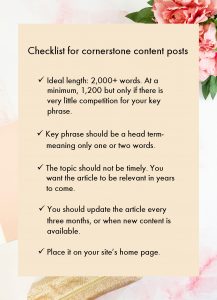
Video: How to mark an article as cornerstone content
Follow-up tasks:
- Determine topics and related key phrases for four articles related to your cornerstone article.
- Write these four articles and link them to the cornerstone article.
- Repeat the above for all your cornerstone content article topics you developed earlier in this module.
- Long-term: try and write a new article, related to one of your cornerstone articles, twice per month. Ideally, they should be 600-750 words long. Put these articles in your monthly blogging plan.
- Create 2-3 new cornerstone articles per year.
- Keep at it!
Are you worried that you might “fall off the wagon” and stop blogging consistently? If so, I run a blogging accountability group just for people that take my courses. Here is a link to join it: Accountability and Support Group with Mary Clare
Key Takeaways
- Internal link help Google crawl your site to learn what it is about and the quality of its content. The more links Google crawlers find to your content, the more domain authority your site will have.
- You can use your site’s internal linking structure to not only help Google crawl your site better, but to tell it the most important content on your site and to help that content rank highly in search.
- You can create content clusters to help you rank for very competitive key phrases. This is done by creating cornerstone content, then writing related articles and linking them to the cornerstone content.
FAQS
Q1 Why don’t you have any category pages in the second step of your pyramid for bespoke-digital-solutions.com?
A1: Because the site is neither an online store, nor a blog that I am trying to monetize by selling affiliate links or advertising space. This is a judgement call on my behalf. My blog is created for the purposes of content marketing. People find my articles because they are looking for information on how to make a website, manage their social media channels or learn about web hosting. Reading the articles drops them into my sales funnel. If I was going straight for the sell, I would put a category page in the second step of my pyramid. For this subdomain, which directly sells products, my product category SEO is in the second step of my pyramid.
Q2: How is link juice passed to the articles on your home page?
A2: Google divides the link value between all links on your home page equally.
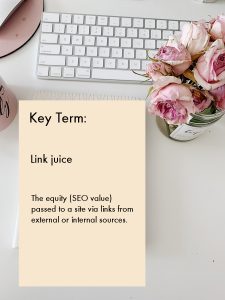
Q3: Can you overdo internal link building? Meaning, are you penalized for too many internal links?
A3: At this time, Google doesn’t penalize a site for too many internal links. However, the other day someone emailed me and asked me to include a link to a page in one of my blog articles. I looked at the page, and there were so many links that I thought it looked spammy and didn’t want to be associated with it. So yes, you can be penalized by users. Make sure to avoid having your post look like the only reason you wrote it was to generate links, or to sell people stuff.
